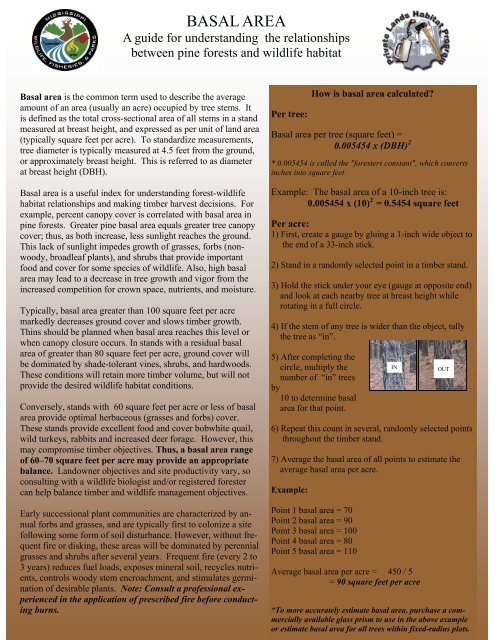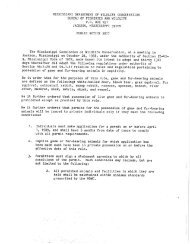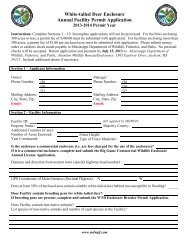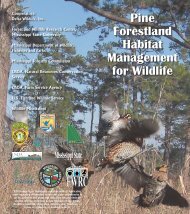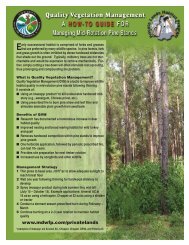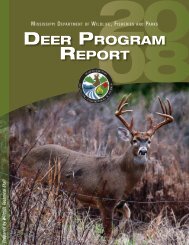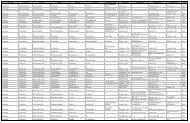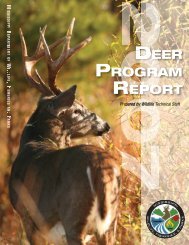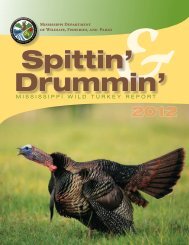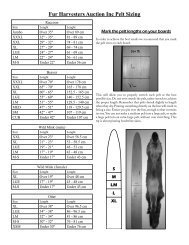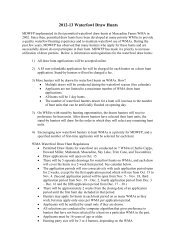BASAL AREA
BASAL AREA
BASAL AREA
- No tags were found...
Create successful ePaper yourself
Turn your PDF publications into a flip-book with our unique Google optimized e-Paper software.
<strong>BASAL</strong> <strong>AREA</strong>A guide for understanding the relationshipsbetween pine forests and wildlife habitatBasal area is the common term used to describe the averageamount of an area (usually an acre) occupied by tree stems. Itis defined as the total cross-sectional area of all stems in a standmeasured at breast height, and expressed as per unit of land area(typically square feet per acre). To standardize measurements,tree diameter is typically measured at 4.5 feet from the ground,or approximately breast height. This is referred to as diameterat breast height (DBH).Basal area is a useful index for understanding forest-wildlifehabitat relationships and making timber harvest decisions. Forexample, percent canopy cover is correlated with basal area inpine forests. Greater pine basal area equals greater tree canopycover; thus, as both increase, less sunlight reaches the ground.This lack of sunlight impedes growth of grasses, forbs (nonwoody,broadleaf plants), and shrubs that provide importantfood and cover for some species of wildlife. Also, high basalarea may lead to a decrease in tree growth and vigor from theincreased competition for crown space, nutrients, and moisture.Typically, basal area greater than 100 square feet per acremarkedly decreases ground cover and slows timber growth.Thins should be planned when basal area reaches this level orwhen canopy closure occurs. In stands with a residual basalarea of greater than 80 square feet per acre, ground cover willbe dominated by shade-tolerant vines, shrubs, and hardwoods.These conditions will retain more timber volume, but will notprovide the desired wildlife habitat conditions.Conversely, stands with 60 square feet per acre or less of basalarea provide optimal herbaceous (grasses and forbs) cover.These stands provide excellent food and cover bobwhite quail,wild turkeys, rabbits and increased deer forage. However, thismay compromise timber objectives. Thus, a basal area rangeof 60–70 square feet per acre may provide an appropriatebalance. Landowner objectives and site productivity vary, soconsulting with a wildlife biologist and/or registered forestercan help balance timber and wildlife management objectives.Early successional plant communities are characterized by annualforbs and grasses, and are typically first to colonize a sitefollowing some form of soil disturbance. However, without frequentfire or disking, these areas will be dominated by perennialgrasses and shrubs after several years. Frequent fire (every 2 to3 years) reduces fuel loads, exposes mineral soil, recycles nutrients,controls woody stem encroachment, and stimulates germinationof desirable plants. Note: Consult a professional experiencedin the application of prescribed fire before conductingburns.Per tree:How is basal area calculated?Basal area per tree (square feet) =0.005454 x (DBH) 2* 0.005454 is called the "foresters constant", which convertsinches into square feetExample: The basal area of a 10-inch tree is:0.005454 x (10) 2 = 0.5454 square feetPer acre:1) First, create a gauge by gluing a 1-inch wide object tothe end of a 33-inch stick.2) Stand in a randomly selected point in a timber stand.3) Hold the stick under your eye (gauge at opposite end)and look at each nearby tree at breast height whilerotating in a full circle.4) If the stem of any tree is wider than the object, tallythe tree as “in”.5) After completing thecircle, multiply thenumber of “in” treesby10 to determine basalarea for that point.6) Repeat this count in several, randomly selected pointsthroughout the timber stand.7) Average the basal area of all points to estimate theaverage basal area per acre.Example:Point 1 basal area = 70Point 2 basal area = 90Point 3 basal area = 100Point 4 basal area = 80Point 5 basal area = 110Average basal area per acre = 450 / 5= 90 square feet per acre*To more accurately estimate basal area, purchase a commerciallyavailable glass prism to use in the above exampleor estimate basal area for all trees within fixed-radius plots.INOUT
1. Burned pine stand with a basal area of 110square feet per acre and little herbaceousground cover.2. Burned pine stand with a basal area of 90square feet per acre.3. Burned pine stand with a basal area of 70square feet per acre.4. Burned pine stand with a basal area of 50square feet per acre.5. Pine stand with a basal area of 70 square feet per acre 2years post-fire with ample herbaceous ground cover.


